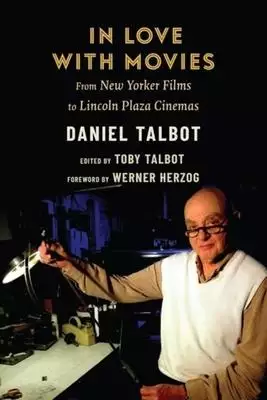new yorker movies的問題,透過圖書和論文來找解法和答案更準確安心。 我們找到下列免費下載的地點或者是各式教學
new yorker movies的問題,我們搜遍了碩博士論文和台灣出版的書籍,推薦寫的 In Love with Movies: From New Yorker Films to Lincoln Plaza Cinemas 和Talbot, Daniel的 In Love with Movies: From New Yorker Films to Lincoln Plaza Cinemas都 可以從中找到所需的評價。
這兩本書分別來自 和所出版 。
國立臺北藝術大學 文創產業國際藝術碩士學位學程(IMCCI) 江美萱、江美萱所指導 Hamana Heloise的 後—新酷兒電影中的酷兒再現 (2021),提出new yorker movies關鍵因素是什麼,來自於電影、酷兒、代表、女權主義、異性戀者。
而第二篇論文國立交通大學 外國語文學系外國文學與語言學碩士班 李家沂所指導 陳子潔的 《機械姬》: 生物演算法的分析與再造 (2020),提出因為有 人工智慧、大腦神經科學、意識、自由意志、生命、機器人、機械姬、生物性演算法、機械性演算法的重點而找出了 new yorker movies的解答。
除了new yorker movies,大家也想知道這些:
In Love with Movies: From New Yorker Films to Lincoln Plaza Cinemas

為了解決new yorker movies 的問題,作者 這樣論述:
Daniel Talbot (1926-2017) founded and ran the New Yorker Theater, Cinema Studio, Metro Theater, and Lincoln Plaza Cinemas as well as the distribution company New Yorker Films. Born in the Bronx, he was an Upper West Sider for almost sixty years. Toby Talbot is the author of The New Yorker Theater an
d Other Scenes from a Life at the Movies (Columbia, 2009). She has taught Spanish and Latin American literature at Columbia and New York University and documentary film at the New School, and has translated numerous works from Spanish, including Jacobo Timerman’s Prisoner Without a Name, Cell Withou
t a Number.
後—新酷兒電影中的酷兒再現
為了解決new yorker movies 的問題,作者Hamana Heloise 這樣論述:
It took a long time for queer representation to come to where it is in today’s films. Queer films have become more and more mainstream since the 1990’s. After several tumultuous fights, queer films were finally able to reach today's availability and popularity. The arrival of New Queer Cinema paved
the way and created many bridges for contemporary queer films. However, representations of some groups of the LGBT community are still overlooked or misrepresented. In other words, although queer films are becoming more accessible, it doesn’t necessarily mean that it shows a positive progress of s
ociety. However, representations of some groups of the LGBT community are still overlooked or misrepresented. In other words, although queer films are becoming more accessible, it doesn’t necessarily mean that it shows a positive progress of society. Many films, whether they are independent or comi
ng from Hollywood, are using the same repressive queer narratives that films use before. They are simply saying it in a more subtle way than before and covering it in different ways. Many still reinforce heterosexual fantasy through their representation of queer characters.However, it is important t
o remember that other films have been attempting to challenge the traditional representation and go toward a more homonormative representation. In this thesis, I delimitated my research to four films that I will analyze: Call Me by Your Name, Blue is the Warmest Color, Moonlight, and Portrait of a L
ady on Fire.hese films are contemporary queer films from the United-States and Europe. I chose these films in the sea of queer films available for various reasons: their overall popularity, their presence on the international queer film scene, the negative news surrounding them, their awards, or the
ir nominations, etc.
In Love with Movies: From New Yorker Films to Lincoln Plaza Cinemas

為了解決new yorker movies 的問題,作者Talbot, Daniel 這樣論述:
Daniel Talbot (1926-2017) founded and ran the New Yorker Theater, Cinema Studio, Metro Theater, and Lincoln Plaza Cinemas as well as the distribution company New Yorker Films. Born in the Bronx, he was an Upper West Sider for almost sixty years. Toby Talbot is the author of The New Yorker Theater an
d Other Scenes from a Life at the Movies (Columbia, 2009). She has taught Spanish and Latin American literature at Columbia and New York University and documentary film at the New School, and has translated numerous works from Spanish, including Jacobo Timerman’s Prisoner Without a Name, Cell Withou
t a Number.
《機械姬》: 生物演算法的分析與再造
為了解決new yorker movies 的問題,作者陳子潔 這樣論述:
電影《機械姬》中,女主角機器人艾娃能夠像人類一樣自己做出決定、思考、構想及執行出策略性計畫。機器人艾娃如人類般的行為不可避免的導向一個疑問:「機器是否可以擁有意識?」要解答這個問題,首先要探討什麼是意識?意識是否是一個物質可以被拆解、進而分析,甚至被製造?又是否只是一個人類生物化學反應下的產物?而容易跟意識產生聯想的自由意志又是什麼?本文透過大腦神經科學研究以及科學實驗,找出意識形成的不同迴路,並且分析人類大腦,找出大腦發送指令的區塊,再透過大腦皮層這個強大的演算法,經由不同意識迴路來達到最初指令的需求。這種指令輸入、演算法程式驅動、達到指令的輸出,是一種生物性演算法。而電影《機械姬》中機器
人艾娃的展現為一種生物性演算法可以被機械性演算法模擬的呈現。若是人類大腦生物性演算法來去對照驗證艾娃機械性演算法模式,我們可以得出了艾娃的行為是符合生物性演算法意識組成的迴路,那麼電影機械姬中的艾娃的展現,就可能是未來機器人的樣貌。《機械姬》不僅僅提供了未來機器人的面貌藍圖,也提供了人類一個對於自身的全新觀點,或許「機器人很像真實人類」的說法將被「人類本身就像機器」取而代之。